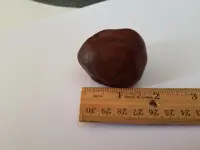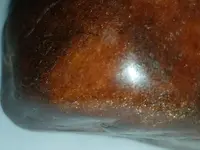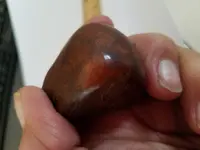suntannedgem
Jr. Member
Hello! I am brand new to this site and in the process of gearing up for a "adventure". Inthe meantimeIhave beenhauling the following along from over 20 years. I thought I had lost it,only to find that it had beenin my father's safe for 15 years.Below are many pictures of a speciman that I found in North East Utah about 6 miles from Dinosaur National Monument around 1996.
I was walking along the road about 5 feet above a dry arroyo. The sun was behind me, it was approximately 11am. As I was walking a bright beam of light hit my eyes from about 100 feet away. I stopped and by moving myself back and forth that the flash was more of a narrow band beam of reddish/ruby/pink colored light. I kept my sight fixed on the beam. I followed the beam into the wall of the arroyo about 4.5 feet down and .5 feet from the bottom. I marked the spot visually as the closer I got to the beam the narrower it became. About 20 feet from the originating signature I dropped down into the arrroyo and walked to the spot that it was located. As I knelt to examine the stone as it was in- situ' I noticed that the beam was quite small and projecting onto my jacket arm. I removed the stone from the wall of the arroyo. I should of marked the side of the stone that was exposed to the sun as I can not get the stone to emit the same beam.
Upon further inspection I noticed the worn hexagonal shapes on different aspects of the stone. In the pictures I have tried to show this geometric shape. From some aspects it looks like a tetrahedron. My father a lapidaritrist with a Master's in geology has even been stumped. He states that it has a hardness of 10. No response to pool chlorine or muriatic acid! The luster is natural.
There is a small corner the size of a button that is shown in the pictures that he attempted to polish. It took him over 3 hours to work that small area enough to get that shine. He also believes that due to the location that the stone may of been a Gastrolith. I have tried with a mag-lite with a enhanced LED bulb to reproduce the beam. I have been able to at times see thru the stone and it appears to be opaque.
Due to the hardness and my father's training we are not cutting the stone as he thinks it maybe something of rare quality and size (200+cwt). Does anyone have any ideas of what it is or where I can take it for 100% identification?
I was walking along the road about 5 feet above a dry arroyo. The sun was behind me, it was approximately 11am. As I was walking a bright beam of light hit my eyes from about 100 feet away. I stopped and by moving myself back and forth that the flash was more of a narrow band beam of reddish/ruby/pink colored light. I kept my sight fixed on the beam. I followed the beam into the wall of the arroyo about 4.5 feet down and .5 feet from the bottom. I marked the spot visually as the closer I got to the beam the narrower it became. About 20 feet from the originating signature I dropped down into the arrroyo and walked to the spot that it was located. As I knelt to examine the stone as it was in- situ' I noticed that the beam was quite small and projecting onto my jacket arm. I removed the stone from the wall of the arroyo. I should of marked the side of the stone that was exposed to the sun as I can not get the stone to emit the same beam.
Upon further inspection I noticed the worn hexagonal shapes on different aspects of the stone. In the pictures I have tried to show this geometric shape. From some aspects it looks like a tetrahedron. My father a lapidaritrist with a Master's in geology has even been stumped. He states that it has a hardness of 10. No response to pool chlorine or muriatic acid! The luster is natural.
There is a small corner the size of a button that is shown in the pictures that he attempted to polish. It took him over 3 hours to work that small area enough to get that shine. He also believes that due to the location that the stone may of been a Gastrolith. I have tried with a mag-lite with a enhanced LED bulb to reproduce the beam. I have been able to at times see thru the stone and it appears to be opaque.
Due to the hardness and my father's training we are not cutting the stone as he thinks it maybe something of rare quality and size (200+cwt). Does anyone have any ideas of what it is or where I can take it for 100% identification?









